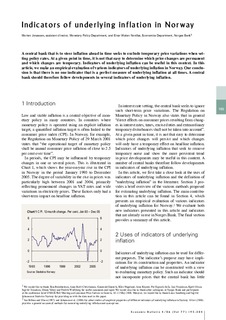| dc.contributor.author | Jonassen, Morten | |
| dc.contributor.author | Nordbø, Einar W. | |
| dc.date.accessioned | 2018-07-04T10:18:57Z | |
| dc.date.available | 2018-07-04T10:18:57Z | |
| dc.date.issued | 2006 | |
| dc.identifier.issn | 0029-1676 | |
| dc.identifier.issn | 1503-8831 | |
| dc.identifier.uri | http://hdl.handle.net/11250/2504291 | |
| dc.description.abstract | A central bank that is to steer inflation ahead in time seeks to exclude temporary price variations when setting policy rates. At a given point in time, it is not that easy to determine which price changes are permanent and which changes are temporary. Indicators of underlying inflation can be useful in this context. In this article, we make an empirical evaluation of various indicators of underlying inflation in Norway. Our conclusion is that there is no one indicator that is a perfect measure of underlying inflation at all times. A central bank should therefore follow developments in several indicators of underlying inflation. | nb_NO |
| dc.language.iso | eng | nb_NO |
| dc.publisher | Norges Bank | nb_NO |
| dc.rights | Attribution-NonCommercial-NoDerivatives 4.0 Internasjonal | * |
| dc.rights.uri | http://creativecommons.org/licenses/by-nc-nd/4.0/deed.no | * |
| dc.title | Indicators for Underlying Inflation in Norway | nb_NO |
| dc.type | Journal article | nb_NO |
| dc.subject.nsi | VDP::Samfunnsvitenskap: 200::Økonomi: 210::Samfunnsøkonomi: 212 | nb_NO |
| dc.source.pagenumber | 195-204 | nb_NO |
| dc.source.journal | Economic Bulletin | nb_NO |
| dc.source.issue | 4/2006 | nb_NO |

